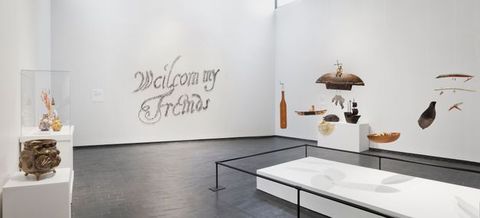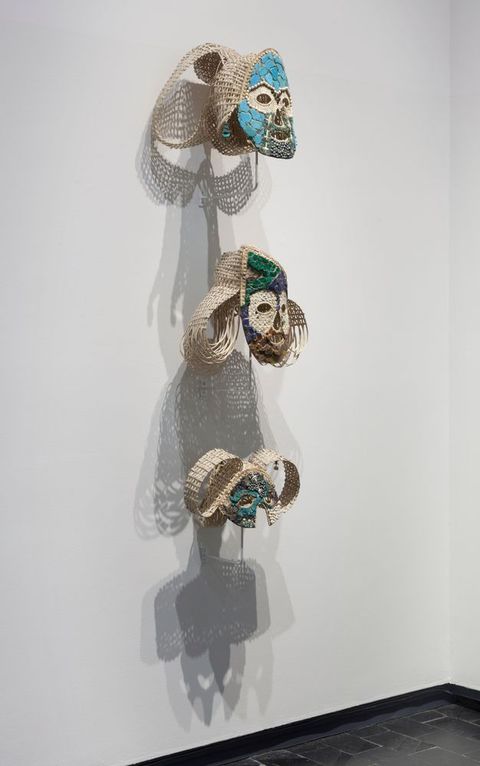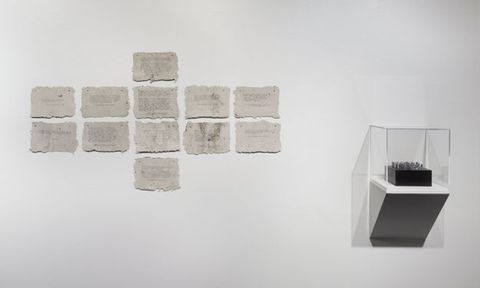Another Crossing
Another Crossing: Artists Revisit the Mayflower Voyage
By Glenn Adamson
Introduction
How can the past be reshaped in the hands of contemporary artists? This feature highlights and archives the work of participants in the exhibition, Another Crossing: Artists Revisit the Mayflower Voyage, presenting an introduction to the exhibition written by its guest curator Glenn Adamson, and the recordings of two virtual events (the second forthcoming in spring 2022) in which the artists reflect on their contributions*.*1 The crossing of the Mayflower in 1620 has been enshrined as a founding myth of American history, one that is eloquently questioned through the revival of seventeenth-century British and Indigenous artisanal practices by a range of contemporary artists. Weaving, firing, and carving are used to reshape the triumphalist language that has typically been used to talk about this historical moment of encounter. In other ways, the artistic techniques shown here raise questions about the tensions between craft and the decorative arts. As the transatlantic context explored in Another Crossing makes clear, the British decorative arts were shaped in untold ways by Indigenous practices and a history of colonization and appropriation, but also by the possibilities of bartering, exchange, and mutuality.
1





Another Crossing
On 6 September 1620, the Mayflower embarked from Plymouth, England, with a crew and 102 passengers. Many were English non-conformists, leaving their homelands for fear that their separatist religious communities would otherwise perish. These self-described “saints” sighted land some two months later. They established a settlement, naming it after the last place they had seen in Europe. Within a year, half were dead. The survivors were among the first to build a permanent home in what seemed to them a “new world”.
But of course, this site was already long inhabited. The Wampanoag people lived in the region, which to them was Patuxet. Many stories have been handed down about this population and its interactions with European settlers—some about mutual reliance, some about conflict. The long-term consequences, however, are not in debate: for the settlers, increasing political dominance; for the Indigenous population, widespread disease, death, and displacement.
The implications of the Mayflower crossing are so far-reaching that they are difficult to comprehend in retrospect. From one point of view, by far the dominant one in American culture, the voyage is a national origin story. For Indigenous peoples, it is just one event within a long and tragic history, its anniversary an occasion for mourning. There is common ground here in the very act of remembrance. But, in 2020, four hundred years after the Mayflower set sail, the distance between those two perspectives could feel vast indeed, more difficult to navigate than an ocean in a wooden boat.
Another Crossing charts a course through this abyss nonetheless. The project is itself a transatlantic collaboration—organized by the Plymouth College of Art and The Box in Plymouth, England, and Fuller Craft Museum, which is in Plymouth County, Massachusetts. During the exhibition’s development, the artists traveled to both sites to better understand the historical context by visiting key locations, and meeting historians, academics, and museum curators. The premise of the show is this: each participating artist has created work in response to the Mayflower’s anniversary, utilizing only technology that existed in 1620. Every work was realized with tools, materials, and processes that were available in the early seventeenth century.
There were several reasons behind this rather demanding parameter. First, it highlights the sophisticated practices that were in use in 1620, like beadwork, joinery, metalsmithing, leatherwork, and pottery. In some ways, people then possessed a greater material intelligence than we tend to today. This is particularly true of Wampanoag and other Native peoples, who possessed complex arrays of artisanal knowledge and artistic métiers. The colonists, too, embarked on their voyage with an extensive range of skills in hand, among them textile crafts and printing.
There is also a more metaphorical intention behind the exhibition’s craft-based time travel: another kind of crossing. Each work in the exhibition simultaneously inhabits two moments—1620 and 2020—or at any rate, vibrates resonantly across that period of four centuries. One cannot fully inhabit a prior moment in time, any more than one can assume another person’s perspective. Each artist had to make their own separate peace with this fact, deciding where and how to draw the boundaries around their project’s period-specificity.
In the exhibition, visitors encounter ten artists, joined together in a collective journey of discovery. The works that they have created are by turns introspective, outraged, sad, funny, surprising, and humane. Each offers its own complex commentary, a bit of wisdom that may help us traverse this anniversary year.
It has been four hundred years since the Mayflower sailed across the Atlantic, to an uncertain future; four hundred years since the Wampanoag witnessed strangers arriving on shore. We are just beginning to understand what happened next. Hopefully, this project makes a modest contribution in that direction.
About the author
-
Glenn Adamson is a curator, writer, and historian based in New York. He has previously been Director of the Museum of Arts and Design; Head of Research at the Victoria and Albert Museum, London; and Curator at the Chipstone Foundation in Milwaukee. Adamson’s publications include Thinking Through Craft (2007); The Craft Reader (2010); Postmodernism: Style and Subversion (2011), accompanying the exhibition of that title at the V&A, co-curated with Jane Pavitt; The Invention of Craft (2013); Art in the Making (2016), co-authored with Julia Bryan-Wilson; and Fewer Better Things: The Hidden Wisdom of Objects (2018). His newest book is Craft: An American History, published by Bloomsbury.
Footnotes
Imprint
| Author | |
|---|---|
| Date | 30 November 2021 |
| Category | In the Artist's Words |
| Review status | Peer Reviewed (Editorial Group) |
| License | Creative Commons Attribution-NonCommercial 4.0 International (CC BY-NC 4.0) |
| Downloads | PDF format |
| Article DOI | https://doi.org/10.17658/issn.2058-5462/issue-21/gadamson |
| Cite as | Adamson, Glenn. “Another Crossing: Artists Revisit the Mayflower Voyage.” In British Art Studies: Redefining the British Decorative Arts (Edited by Iris Moon). London and New Haven: Paul Mellon Centre for Studies in British Art and Yale Center for British Art, 2021. https://doi.org/10.17658/issn.2058-5462/issue-21/gadamson. |
